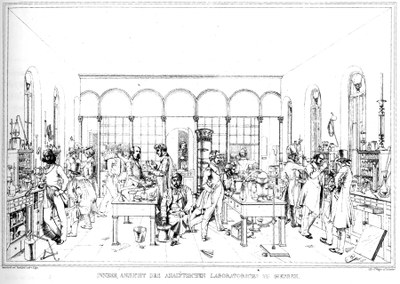Analytical Laboratory in Giessen, 1842

This illustration shows Liebig's laboratory as a space for the collective endeavours of students and teachers from various countries. The principle of division of labour is also affirmed here. The laboratory does not only appear as a workshop, but also as a transit point of ideas and discourses. Additionally, one of the internal architectural innovations of Liebig can be seen. In older laboratories, the experimentation tables were usually placed against the wall, with one free-standing table placed in the middle. Liebig distributed the experimentation tables throughout the whole room. This meant that more experiments could be performed simultaneously and more students could be accommodated, while the laboratory director could easily retain an overview of the activities.
Interior View of the Analytical Laboratory in Giessen, lithograph, from a drawing by Wilhelm Trautschold (1815–1877) and Hugo von Ritgen (1811–1889), 1842, unknown artist; source: Hofmann, J. P.: Das chemische Laboratorium der Ludwigs-Universität zu Gießen, Tafeln, Heidelberg 1842, table VII.